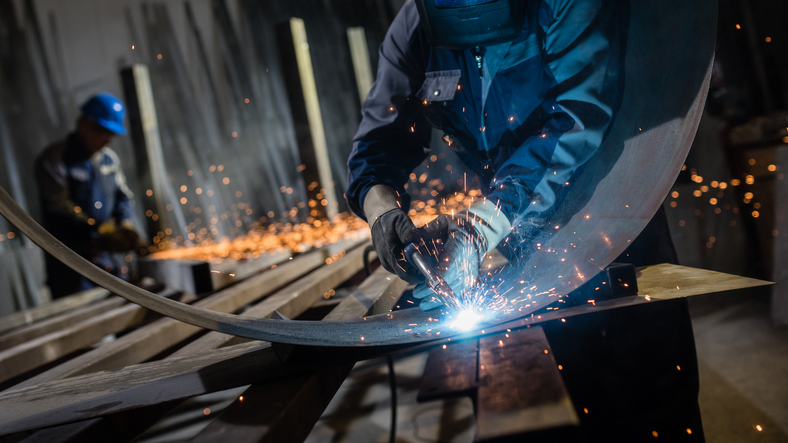
Sheet Metal Worker
In the unpredictable environment of a jobsite where workers might be hanging on to a ladder with one hand, this becomes a task only the most skilled and athletic can master.
Sheet metal workers cut, bend, shape, and attach metal, plastic, and fiberglass raw materials for a variety of purposes in the building trades. Although HVAC is the industry that first springs to mind because of the large amount of ductwork needed to channel air through buildings, sheet metal workers handle any sort of fabrication or installation dealing with thin form materials:
Life as a Sheet Metal Worker
Sheet metal work is grittier, more hands-on, and more labor-intensive than any other HVAC subspecialty. Heavy lifting is an integral part of the job. Sheet metal workers are more likely to be muscling big ducts or machinery into place in awkward positions than to be doing finesse work with wires or compressors.
They are experts at working with their hands and with machinery. The materials they work with are hard and unforgiving. If you have never heard the phrase “Measure twice, cut once” before, be prepared to hear it a lot if you get into the sheet metal trade.
The one tool no sheet metal worker is ever without is a pair of shears. Watching a master go to work with a basic handheld pair of snips on a blank piece of sheet metal is like watching one guy with a chisel carve out Mount Rushmore. The metal spins, shards fly, and suddenly you’re looking at a fully-formed fitting.
Your grip and Pop-Eye forearms will be the envy of your friends after a few years on the job.
Almost alone in the HVAC-related trades, sheet metal work has a very predictable work cycle. There are almost never any emergency service calls for ductwork—installations or repairs are planned ahead of time, resulting in a regular schedule.
That’s not to say the job doesn’t come with overtime. When projects are running behind, the hours will stack up for the taking, sometimes resulting in ten or twelve hour days on the job.
On-site Sheet Metal Work
Ducting installation is considerably more difficult in an existing building and most building owners do everything they can to avoid the expense. This means most sheet metal workers will be employed working in new construction.
Although this has the advantage of easier access and not having to worry much about working around pesky things like walls or floors, it does mean working in the open air. Sheet metal installers might work at height, on roofs or near ceilings, and have to be familiar with all the necessary safety equipment.
Some fabrication happens on-site, performed either manually or with power tools. There isn’t a ducting installation in the world that has gone into place completely according to the design specs… adjustments have to be made all the time. It takes an expert eye both to read blueprints and diagrams and to assess spaces for the best way to build the system.
Sheet Metal Shop Work
A lot of sheet metal work happens off-site. Expert fabricators create ductwork and fittings in well-equipped shops, using specialty tools that aren’t easily carted around on job sites – things like:
- Spot welding machines
- Pressure rollers
- Brake metalworking machines including:
- Cornice brakes – A single clamping bar machine for straight bends
- Box-and-pan brakes – A more complex brake that can create pan or box shapes by rearranging internal bars
- Press brake – A machine that makes complex shapes through the use of a clamp and die process.
- Power shear cutting machines
- Laser or pressure jet cutting machines
These can be manually operated or hydraulically powered, depending on the material type and sizes they are intended to work on.
Many of the machines are now computer controlled and can create intricate three-dimensional shapes out of raw metal sheets.
Knowing The Materials is Half The Battle
Ducting is usually made out of aluminum or galvanized steel. Sheet metal workers have to be familiar with the unique properties of each of those metals, as well as more exotic materials they are sometimes called on to work with in modern construction, namely fiberglass.
Preparing for a Career as a Sheet Metal Worker
Unlike a lot of HVAC careers, the rate of technological change in sheet metal is not exactly moving at a breakneck pace. A master craftsman from the early 20th Century could walk into the union hall and get a pretty good job today without any serious retraining.
But that’s not to say that training isn’t necessary. Sheet metal is an enormously unforgiving material to work with. It takes a lot of practice, under the eyes of skilled journeyman and masters, to get to even a basic level of skill in the field.
In some states, you may also need to become licensed to work in sheet metal. Massachusetts, for example, requires 4800 hours of on-the-job training as an apprentice and 450 hours of classroom time over a period of at least 3 years.
The most common way to get this level of training is through an apprenticeship. Most sheet metal work apprenticeships today are offered through the sheet metal union, SMART (Sheet Metal | Air | Rail | Transportation). Some non-union shops will hire apprentices but the training program may not be as formal as those offered by the unions.
Apprenticeships are hard to come by and there is a great deal of competition when openings come up.
Whether union or non-union, apprentices will be learning skills that include:
Some trade schools exist that teach sheet metal work but most often these are designed as part of or preparation for a regular apprenticeship.
Sheet metal workers may continue in the trade or eventually shift over into more mainstream HVAC work. Since large sheet metal installation jobs are almost all commercial, this is one route into the coveted commercial HVAC sector.
